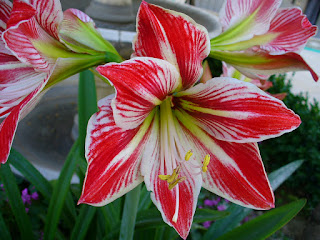I realize that I’m prone to thinking of the plant world in terms of competition. I suppose this is an over-simplification of Darwinian thought: we picture the garden as a battle for resources where the fittest survive. Experience bears this out when we see aggressive plants-- nonnative invasives but also native plants and imports that happen to be in their best growing environment--crowding out plants that are less well-suited for a particular niche in time and space.
 |
| Sweet woodruff ruling the shade garden |
As I learn more about the science of soil and plant communities, though, I find that there’s a lot of cooperation in addition to the competition I tend to notice. The first hint came in junior high, when we were taught the concept of symbiosis through the example of lichens, which, we were told, are a cooperation between fungi and algae. As lichenologist Trevor Goward says, “Lichens are fungi that have discovered agriculture.” The algae provide the fungi with energy through their photosynthesis, and the fungi provide protective structure. It turns out there’s a third partner in this cooperative effort, recently discovered. It’s a kind of yeast.
 |
| Lichens are a cooperative effort-photo Alex Proimos |
But there’s more. In The Hidden Life of Trees, forester Peter Wohlleben describes trees as social beings that share nutrients and warn each other of impending danger through their roots. Teaming with Microbes, a fascinating and useful book by Jeff Lowenfels and Wayne Lewis, describes the soil food web, the network of soil organisms that work together to provide plants’ roots with needed nutrients. Each soil organism has something to gain in the complicated transactions going on in the top few inches of soil.
 |
| Soil microbes-photo courtesy of Pacific Northwest National Lab |
Fungi called mycorrhizae grow in symbiosis with roots, providing water and nutrients in exchange for carbohydrates made by leaves. Free-living fungi, bacteria, nematodes, protozoa, small insects, and earthworms all seek food for themselves and, as a byproduct of their labor, provide food for others in the network. Each organism has evolved to play its part. It’s interesting that evolution has favored cooperation in this system, not just competitive success.
 |
| Fungi play an important role in decomposition |
Above ground there are similar processes at work. When we plant perennials, we tend to think they need plenty of space so they won’t have to compete for water, sunshine, and nutrients as they get established.
 |
| Perennials spaced out for traditional planting |
A newer, more natural way of planting recommends closer spacing of different kinds of perennials to form plant communities.
Some perennials grow upright and tall, others make wide rosettes of leaves or hug the ground and weave their stems between taller growers. Some have taproots that grow straight down, many others create a mat of slender root fibers. Some take off fast in newly open ground, others grow more slowly but persist longer.
 |
| Perennials with different growth habits can grow close together |
By working around each other in space and time, the plants get what they need and also help each other by providing shade, edging out intruders, and holding moisture in the soil. In community there is strength.















